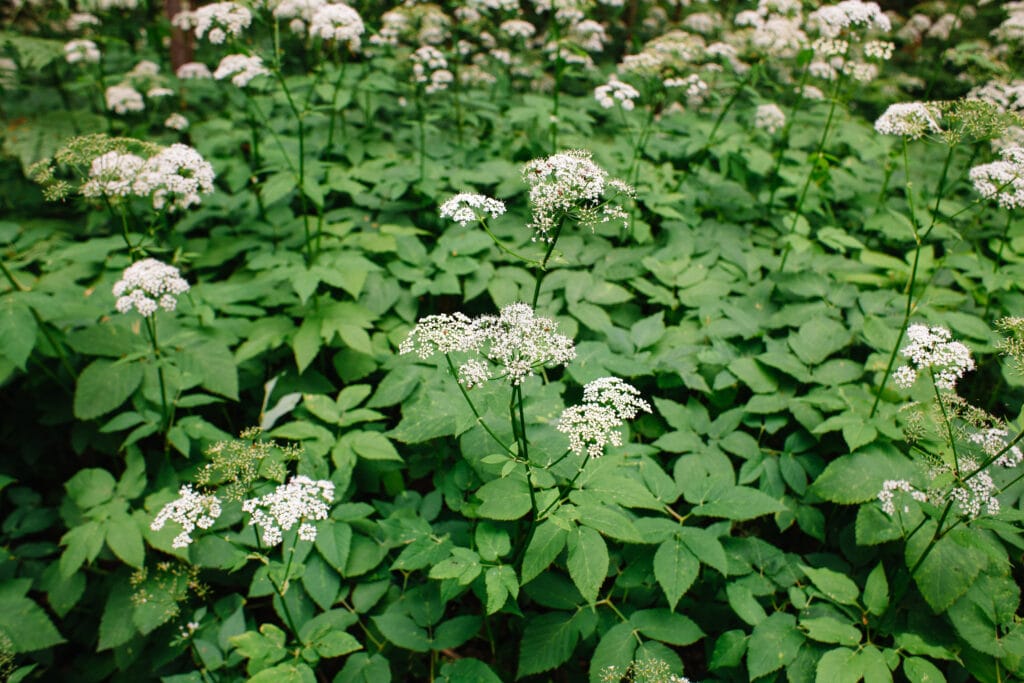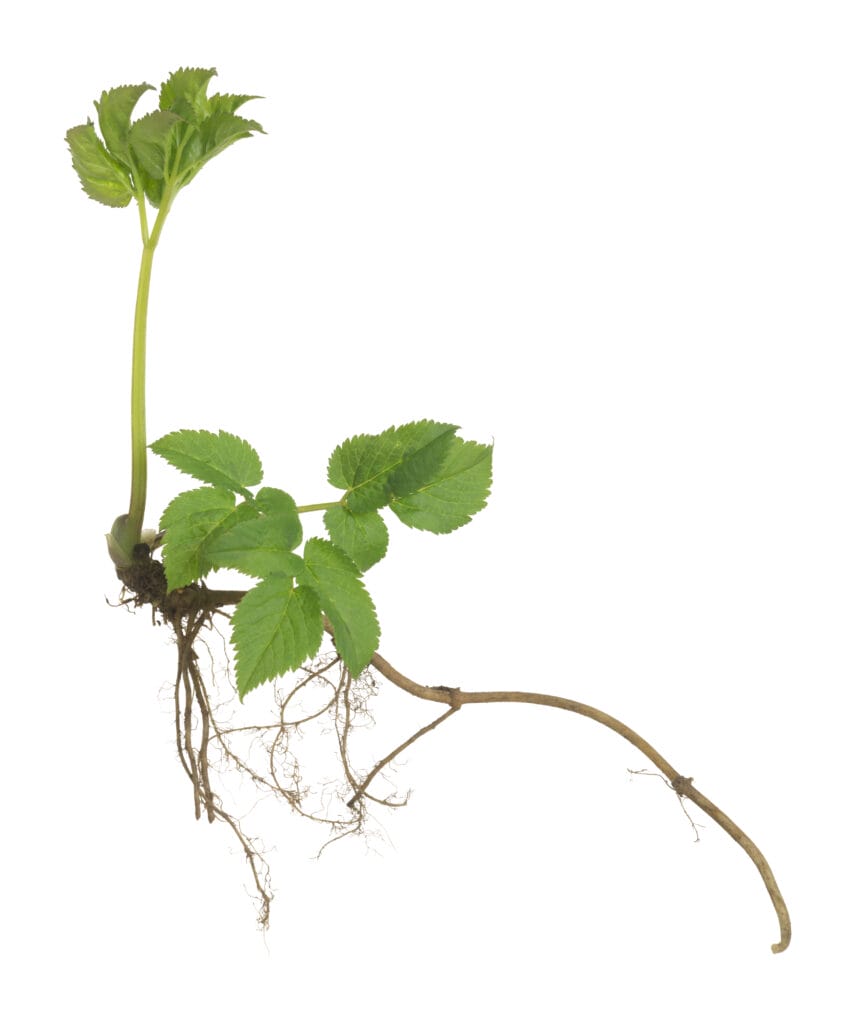Like many of its rhizomatous cousins, ground elder (Aegopodium podagraria), is capable of spreading quickly and swamping other, smaller plants. Once it has a foothold, common ground elder propagates quickly via rhizomes, and to a lesser extent seeds. Removing ground elder roots (or rhizomes) from a large area can be difficult, simply based on the volume of plant matter it’s necessary to dig out. Keen gardeners across the UK will know this umbellifer for its ability to return from the tiniest fragments in borders, lawns and in features such as gravel paths. Ground elder is not classified as an invasive species as it has been naturalised to the UK after thousands of years. However, it is recognised as a problem plant that displays invasive characteristics. Despite this, after identifying ground elder, successful treatment of the tenacious plant is possible and ground elder removal can even be achieved.
Is ground elder invasive?
In several states across the US, and regions of Australia, ground elder (also known as goutweed) is acknowledged as a problematic invasive species. However, whilst ground elder is widely recognised as a problematic and pervasive weed in the UK, it is not a ‘listed’ invasive species. In the UK, the term ‘invasive species’ is typically reserved for non-native plants and animals that have a significant negative impact on native biodiversity, economy, or human health. Plants and animals of the type are recorded in Schedule 9 of the Wildlife & Countryside Act 1981.
Ground elder certainly displays ‘invasive characteristics’. It is energetic and an early starter, putting out new growth in late winter and early spring before many plants have even woken up. Ground elder is also adaptable, enjoying shady conditions (where the competition is lower) but also happy and capable in sunnier areas. Aside from being able to spread by seed, although this is uncommon in the UK, ground elder primarily uses rhizomes (underground stems) that spread in the soil and store energy for when needed.
Controlling ground elder can be difficult because it’s aggressive and even small fragments of rhizomes left in the soil can lead to new plant growth. This is the same principle by which Japanese knotweed, the most notorious non-native invasive species, spreads. Combatting Japanese knotweed rhizomes is key to successfully dealing with that plant, similarly rhizomes are the target when tackling ground elder.

The leaves an white flowers of Aegopodium podagraria L. Commonly referred to as ground elder, bishops weed and goutweed iStock/Mikhail Martirosyan
Ground elder treatment
Herbicides can be an effective ground elder treatment, however, do read, understand and follow the manufacturer’s instructions to ensure safe and effective application of the product. However, HSE Pesticide guidance places the onus on the user for the safe and proper use of these:
If you use pesticides in your garden, allotment, or on houseplants you are legally responsible for using them correctly and effectively. You must keep your garden and allotment safe for people, pets and wildlife.
Professional herbicide treatment
Many effective products are not available to the general public to purchase. Users of these professional products are required to have a certificate of confidence. The choice of herbicide for ground elder treatment will depend on factors including the location of the plant, nearby vegetation, and environmental considerations such as proximity to water bodies*.
Glyphosate is a popular herbicide, but it’s non-selective, meaning that it will damage a very wide range of plants, including ground elder. This means that it must be applied extra carefully where plants you don’t want to damage, or kill, are nearby. Triclopyr is a more selective herbicide – for example, it has little effect on most grasses – but still needs to be used with care and must not be used near any water bodies.
When approaching ground elder control with the use of herbicides, PBA applies the treatment during the active growing season, to ensure the plant transports this to the rhizomes. Multiple applications of herbicide may be necessary to gain complete control of ground elder, as some of the rhizomes may escape initial treatments. Before opting to use herbicide for ground elder control, consider the other options available. Integrated pest management, which combines chemical control with other methods like manual removal and mulching, can be an effective approach for managing ground elder infestations.
* When planning on using herbicides anywhere near a water body, an application to the Environment Agency (EA) will be required. PBA Solutions makes these applications on behalf of a client as part of an invasive weed management plan, and prior to commencing any treatment.
How to remove ground elder roots

Ground elder (Aegopodium podagraria) plant displaying rhizomes and roots iStock/Henrik_L
Manually and methodically digging through soil where ground elder is growing can be an effective way of removing ground elder roots and rhizomes. Though, this method is only practical on a smaller scale because the process may have to be repeated a few times. Ground elder will regrow from tiny sections of rhizome, and finding every last fragment on the first dig is unlikely. Whilst the rhizomes are quite thin (usually only a millimetre or two in diameter), they are quite a bright white, and fairly easy to spot in most conditions.
Once removed, waste rhizome can be bagged and left for as long as it takes to dry out completely or decay to the point where it isn’t viable. This waste can then be composted or, to be sure that the job is done, incinerated. If you do decide to compost, be sure to check back and examine for any new growth. Very large infestations of ground elder can be excavated mechanically, using a mini-digger. This makes sense where a very quick result is needed. The ground elder root system can be completely excavated in one go, thereby removing the need for manually digging out the ground elder.
How to dispose of ground elder
When thinking about how to dispose of ground elder, you may be relived to hear that it is not subject to any legislation. You can put ground elder roots and rhizomes into your green waste bin without infringing the law. This is one advantage of the plant not being listed in the Wildlife and Countryside Act 1981 as a non-native species.
Liquid feed
An alternative to binning or composting the ground elder waste is to make a liquid feed from it. This is a simple process, involving nothing more than placing the leaves, stems, rhizomes and roots into a bucket of water and waiting for nature to do its thing. The solids will gradually rot down in the water, releasing nutrients as it decays. The resulting liquid can be used as a multi-purpose feed for your other plants, and the slimy goop at the bottom of the bucket can be added to your compost. Of course, you’re not limited to only using the ground elder waste in this way, as many other plants will be suitable for this natural recycling process.
Whichever disposal method you choose, ensure that the ground elder rhizomes have lost viability before disposing of them. This is really only way of stopping the cycle of them spreading. Should the prospect of dealing with ground elder yourself prove a daunting one, PBA Solutions would arrange to take any waste material to a licensed landfill as part of the removal process.
If you need help removing or treating common ground elder or any invasive native or non-invasive plants, call 0203 174 2187 or 01202 816134 to talk to one of our consultants today.
Lead image iStock/emer1940

